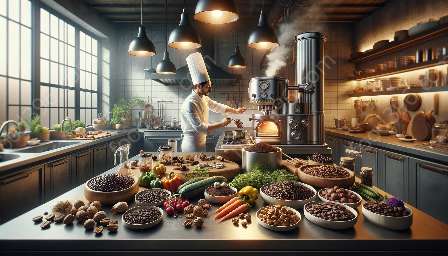Glazing and roasting are essential techniques in the art of food preparation. Whether you're a seasoned chef or an amateur cook, mastering these methods can elevate your dishes to new heights. In this comprehensive guide, we'll explore the science behind glazing and the perfect roasting techniques that will delight your taste buds.
The Art of Glazing
Glazing is a cooking technique that involves adding a glossy, flavorful coating to a food item. This coating not only enhances the appearance of the dish but also adds depth and complexity to its flavor profile. The process of glazing typically involves sugar, fat, and a liquid component, which are heated together until they form a thick, shiny glaze.
Glazing can be used to enhance both savory and sweet dishes. For savory dishes, a glaze might consist of a reduction of stock, wine, or vinegar, while sweet glazes often feature sugar, honey, or fruit juices. The key to successful glazing lies in achieving the right balance of sweetness, acidity, and viscosity, which can transform a simple ingredient into a show-stopping centerpiece.
The Science of Glazing
Glazing is not only an art but also a science. The process of caramelization plays a crucial role in the development of a glaze. When sugar is heated, it breaks down and undergoes a series of complex chemical reactions that result in the browning and development of rich flavors. Understanding the science of caramelization allows chefs to harness its transformative power and create glazes that are both visually stunning and irresistibly delicious.
The Perfect Roasting Techniques
Roasting is a dry-heat cooking method that involves cooking food in an oven or over an open flame. The heat from the oven caramelizes the natural sugars in the food, creating a deep, rich flavor and irresistible aroma. From roast chicken to roasted vegetables, this cooking technique has been a staple in kitchens around the world for centuries.
The Science of Roasting
Roasting is a delicate balance of heat, time, and technique. The Maillard reaction, which occurs when proteins and sugars in the food are exposed to high heat, is responsible for the golden brown color and complex flavors that develop during roasting. The process of roasting also promotes the evaporation of moisture from the surface of the food, resulting in a crispy, caramelized exterior and a tender, juicy interior.
Mastering the science of roasting allows cooks to achieve perfectly cooked dishes that are bursting with flavor and texture. Whether you're roasting a whole turkey for Thanksgiving or a medley of seasonal vegetables for a weeknight dinner, understanding the science behind roasting is the key to culinary success.
The Marriage of Glazing and Roasting
When the art of glazing meets the perfect roasting techniques, culinary magic happens. Imagine a succulent pork loin, glazed with a tangy apple cider reduction and slow-roasted to perfection. Or picture a medley of winter root vegetables, glazed with honey and herbs and roasted until they caramelize and become tender, creating an unforgettable side dish.
The combination of glazing and roasting allows cooks to create dishes that are as beautiful as they are delicious. The glaze adds a layer of complexity and depth to the food, while the roasting process intensifies the flavors and textures, resulting in an irresistible culinary experience.
Conclusion
Glazing and roasting are not just cooking techniques—they are an art form and a science. By mastering the art of glazing and the perfect roasting techniques, you can elevate your culinary creations to new heights. Whether you're cooking for yourself, your family, or a crowd, the knowledge and skills you gain from understanding these methods will transform your time in the kitchen into a delightful and delicious adventure.

